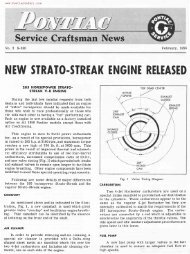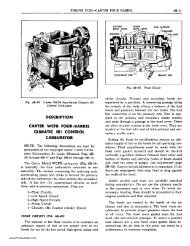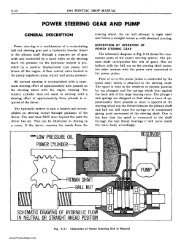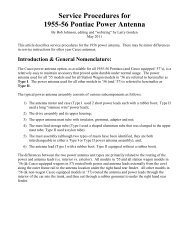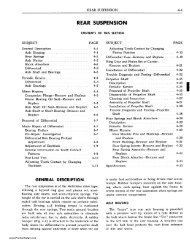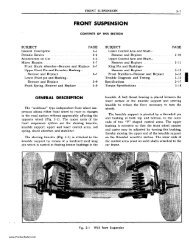Contents / General Description / Carter WGD 2
Contents / General Description / Carter WGD 2
Contents / General Description / Carter WGD 2
Create successful ePaper yourself
Turn your PDF publications into a flip-book with our unique Google optimized e-Paper software.
68-4 1955 PONTIAC SHOP MANUAL<br />
ANTI· PERCOLATOR PASSAGES<br />
METERING<br />
ARM<br />
METERING "IH---4-+1<br />
ROD<br />
Fig. 6B·5<br />
High Speed Circuit-<strong>Carter</strong><br />
the metering rod countershaft arm. Movement of the<br />
metering rods will then be controlled by the metering<br />
rod countershaft arm which is connected to the<br />
throttle shaft. This is true at all times that the<br />
vacuum under the piston is strong enough to over·<br />
come the tension of the vacumeter spring.<br />
VACUUM METERING ROD ACTION<br />
Under any operating condition (acceleration, hill<br />
climbing, etc.), when the tension of the vacumeter<br />
spring overcomes the pull of vacuum under the<br />
piston, the metering rods will move toward their<br />
wide-open throttle or power position.<br />
ANTI-PERCOLATOR<br />
To prevent the vapor bubbles in the nozzle passages<br />
and low-speed wells caused by heat from<br />
forcing fuel out of the nozzles, anti-percolator passages,<br />
and calibrated plugs and bushings are used.<br />
Their purpose is to vent the vapors and relieve the<br />
pressure before it is sufficient to push the fuel out<br />
of the nozzles and into the intake manifold. Antipercolator<br />
plugs, bushings, and main nozzles are<br />
permanently installed and must not be removed in<br />
service.<br />
PUMP CIRCUIT (FIG. 6B-6J<br />
The accelerating pump circuit provides a measured<br />
amount of fuel, which is necessary to insure smooth<br />
engine operation for acceleration at low speeds.<br />
When the throttle is closed, the pump plunger<br />
moves upward in its cylinder and fuel is drawn into<br />
pump cylinder through the intake check. (Fig. 6B-7).<br />
The discharge check is seated at this time to prevent<br />
air being drawn into the cylinder. When the throttle<br />
is opened the pump plunger moves downward<br />
forcing fuel out through the discharge passage, past<br />
the discharge check, and out of the pump jets. When<br />
the plunger moves downward the intake check is<br />
closed preventing fuel from being forced back into<br />
the bowl.<br />
At higher speeds pump discharge is no longer<br />
necessary to insure smooth acceleration. When the<br />
throttle valves are opened, a pre-determined amount,<br />
the pump plunger bottoms in the pump cylinder<br />
eliminating pump discharge due to pump plunger<br />
movement at high speeds.<br />
www.PontiacSafari.com



